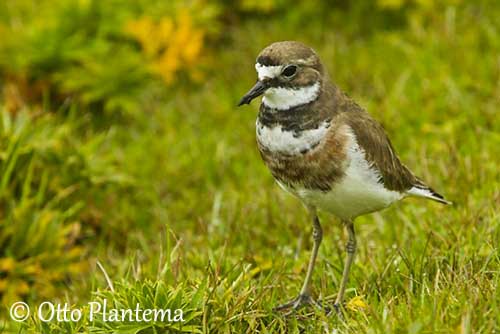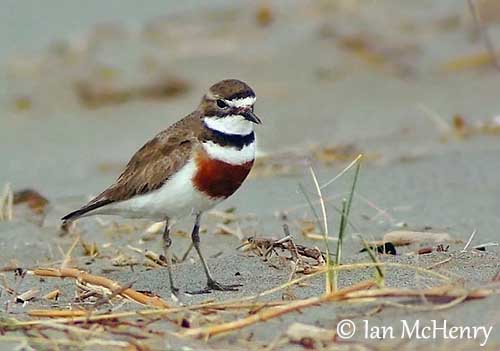
Fr: Pluvier à double collier - Gravelot à double collier
Maori: Tutuwhatu
Ang: Double-banded Plover - Banded Dotterel
All: Doppelband-Regenpfeifer
Esp: Chorlitejo Bicinchado
Ita: Corriere dai due collari
Nd: Dubbelbandplevier
Sd: Dubbelbandad strandpipare
Photographers:
Ian McHenry
My New Zealand Birds
Otto Plantema
Trips around the world
Simon Tan
PBase Bird galleries
Text by Nicole Bouglouan
Sources:
HANDBOOK OF THE BIRDS OF THE WORLD Vol 3 by Josep del Hoyo-Andrew Elliott-Jordi Sargatal - Lynx Edicions - ISBN : 8487334202
KNOW YOUR NEW ZEALAND BIRDS by Lynnette Moon - New Holland Publishers – ISBN: 1869660897
SHOREBIRDS by Peter Hayman, John Marchant and Tony Prater – Christopher Helm – 1986 – ISBN: 0747014035
BirdLife International (BirdLife International)
New Zealand bird status between 2008 and 2012
Te Ara – The Encyclopedia of New Zealand
New Zealand birds and birding (Narena Olliver)
Wikipedia, the free encyclopaedia
Birds in backyards (Birds Australia and Australian Museum)
Double-banded Plover or Banded Dotterel
Charadrius bicinctus
Charadriiformes Order – Charadriidae Family
INTRODUCTION:
The Double-banded Plover is endemic to New Zealand where it is abundant and widespread on seashores, in estuaries and riverbeds. It is known as Banded Dotterel in New Zealand and the Maori’s name is Tutuwhatu.
The population is currently declining, due to introduced mammalian predators which take both eggs and chicks in the nest on the ground.
DESCRIPTION OF THE BIRD:
Biometrics:
Length: 18-21 cm
Wingspan: 37-42 cm
Weight: 47-76 g – Race exilis: 78-89 g
The adult in breeding plumage has rich grey-brown upperparts but the rump has white sides and the outer rectrices are whitish. The flight feathers are blackish.
The underparts are white, but we can see a broad chestnut breast band and a narrower black neck band.
On the grey-brown head, there is a narrow, black, frontal bar above the white forehead. Chin, throat and lower cheeks are white.
The bill is black. The eyes are dark brown. Legs and feet are pale grey-green to yellowish-green.

The non-breeding adult has reduced breast bands with only greyish lateral patches.
The female resembles male but the breast bands are duller.
The juvenile is often greyer than adults. The dorsal feathers have pale edges giving mottled appearance. Breast bands are indistinct.
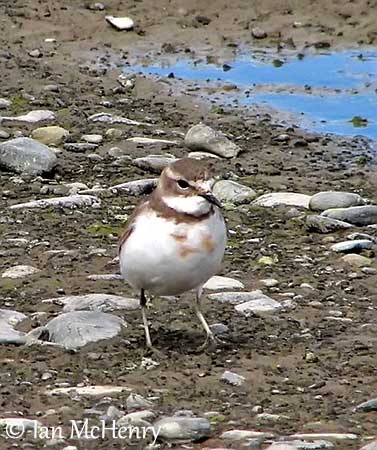
The race exilis from Auckland Islands is plumper and heavier, with longer legs. The breast bands are duller and flecked with white. The female has warmer brown upperparts and duller breast bands.
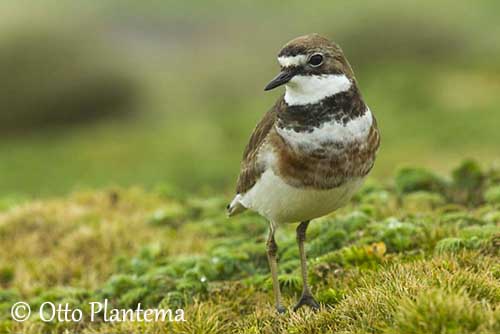
SUBSPECIES AND RANGE:
The Double-banded Plover has two subspecies, here described and displayed.
C.b. bicinctus is found in New Zealand and Chatham Islands. This race is partially migratory and winters to S and E Australia, Tasmania, Norfolk Island and Lord Howe Island, New Caledonia, Vanuatu and Fiji.
C.b. exilis is found on Auckland Islands where it is resident.
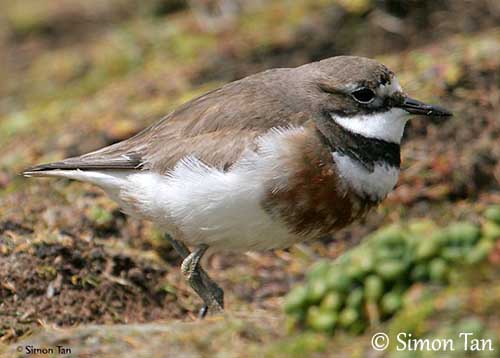
Race exilis
Enderby Island
HABITAT:
The Double-banded Plover breeds in a variety of habitats such as sandy coasts near streams or river mouths, but it prefers shingle riverbeds in the lower North Island, and the braided riverbeds in South Island near Canterbury. It can also nests in the Rangipo desert in North Island, as well in high altitude riverbeds, farmlands and grass paddocks.
Outside the breeding season, it frequents coastal and freshwater wetlands, beaches and salt-lakes, grassland and pasture.
The race exilis breeds in alpine areas of highest hills on Auckland Islands.
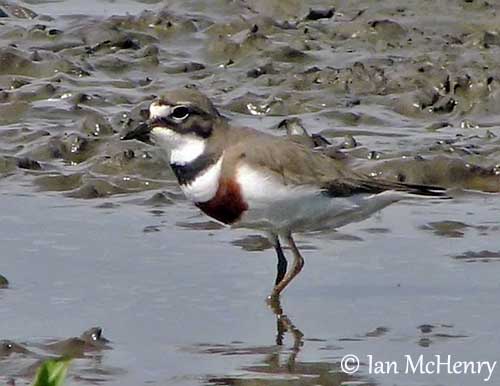
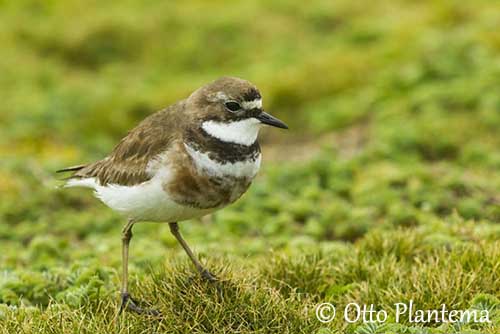
CALLS AND SONGS: SOUNDS BY XENO-CANTO
The Double-banded Plover utters soft “chip” call in flight. This sound is sometimes repeated 3-4 times. When they fly in flocks, these calls are similar to continuous chattering.
During territorial defence behaviour, the bird gives “pink” sounds while threatening an intruder. The male puffs out its breast feathers while calling “chee-aree-aree” or a repeated “whee-chedlet” during aggressive encounters.
It produces clicking sounds with the wings during the flight displays.
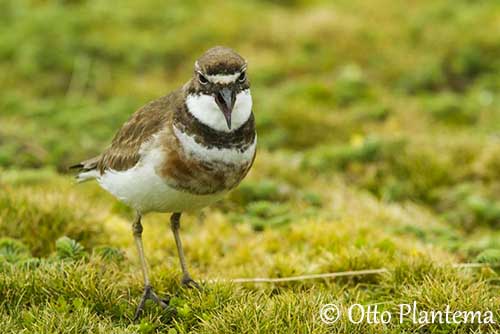
BEHAVIOUR IN THE WILD:
The Double-banded Plover feeds on crustaceans, molluscs and marine worms, and it takes flies found in wet sand and saltmarshes. But it mainly forages in sandy mudflats and estuaries, according to prey availability.
During the breeding season, the diet includes mostly spiders, beetles, insect larvae, aquatic and terrestrial insects. It may occasionally consume berries in low foliage. It forages in pastures and ploughed fields along coasts and riverbeds. It feeds at night at estuaries.
The race exilis often wades into rock pools to find aquatic preys.
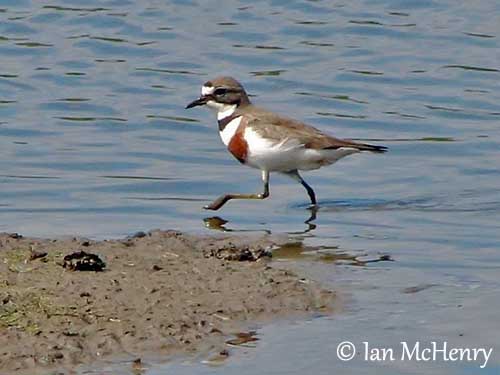
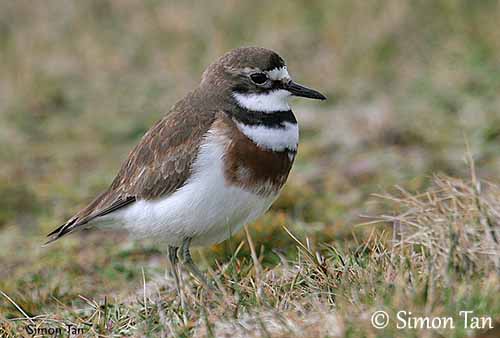
Race exilis
Enderby Island
The Double-banded Plover roosts in flocks at traditional sites outside the breeding season. The nightime roosts are often on islets, headlands and protected beaches at high tide. These flocks may contain several hundreds of birds.
During the breeding season, the male performs courtship displays and defends strongly the territory. It flies towards the intruder by circling in fast butterfly-like flight. It also runs and makes bobbing movements.
It attracts females by calling loudly. Usually, the male builds several nests and the female chooses one among them. They are seasonally monogamous.
The Double-banded Plover of nominate race is partially migratory from New Zealand to Australia, and mainly the birds that breed inland or above 600 metres of elevation. They migrate to N New Zealand, E and S Australia and Tasmania. The birds which breed in coastal areas are mostly sedentary.
The race exilis may perform some local movements, reaching the shores of Enderby Island in winter. But most birds remain on their territories.
The Double-banded Plover has long-pointed wings and is very agile in flight. It is able to travel long distances.
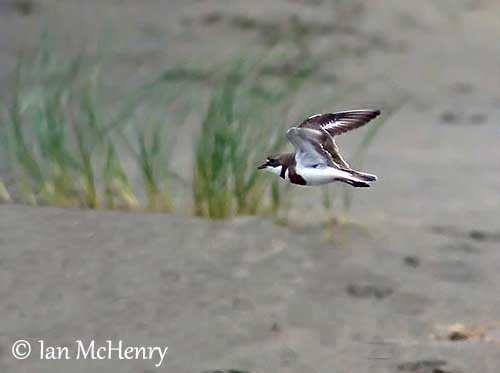
REPRODUCTION OF THIS SPECIES:
The Double-banded Plover arrives on the breeding grounds in July, and the laying occurs between August and early November in lowlands, and mainly in October at higher elevation.
The pairs nest usually solitary, but in good and suitable habitat, there is sometimes high concentration of birds.
The nest is a shallow depression made in gravel, sand or soil. The scrape is often lined with small stones or shells, and fragments of foliage or other vegetation available in the surroundings.
The female lays 2-3 grey to pale olive eggs with dark spots. Both adults share the incubation during 25-28 days. The chicks are precocial and leave the nest soon after hatching. They have grey or buff down with some dark markings, a cryptic colour for better protection on the ground. They fledge 5-6 weeks after hatching, but both parents tend them for two weeks after fledging.
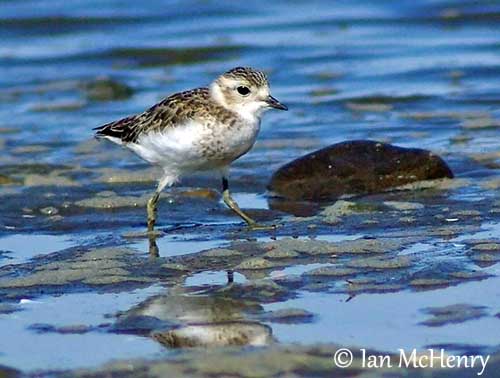
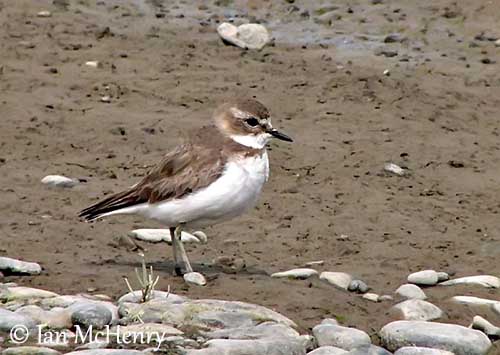
This species usually produces a single brood, but up to 3 replacement clutches may occur. The adults perform the typical “broken-wing” display to lead predators away from the nest, and also predation-displays near the nest.
PROTECTION / THREATS / STATUS:
The Double-banded Plover’s population is estimated at about 50,000 birds and is declining due to introduced mammalian predators.
There are currently about 730 individuals of race exilis in Auckland Islands.
Habitat loss along with human activities is a major threat at breeding sites.
However, the species is currently evaluated as Least Concern.
